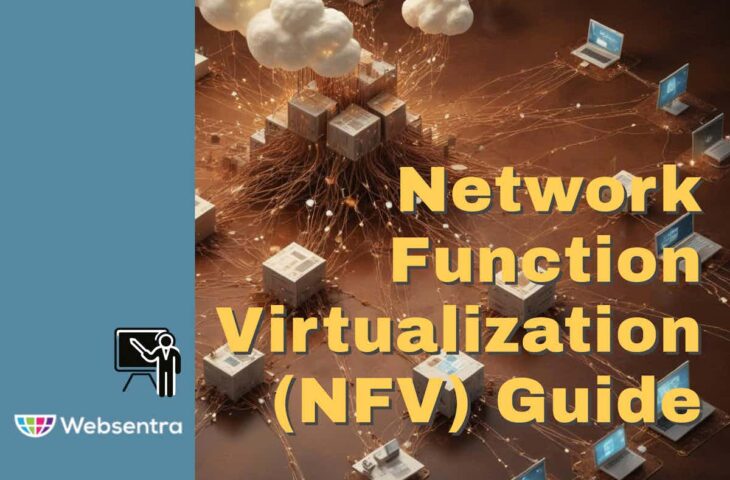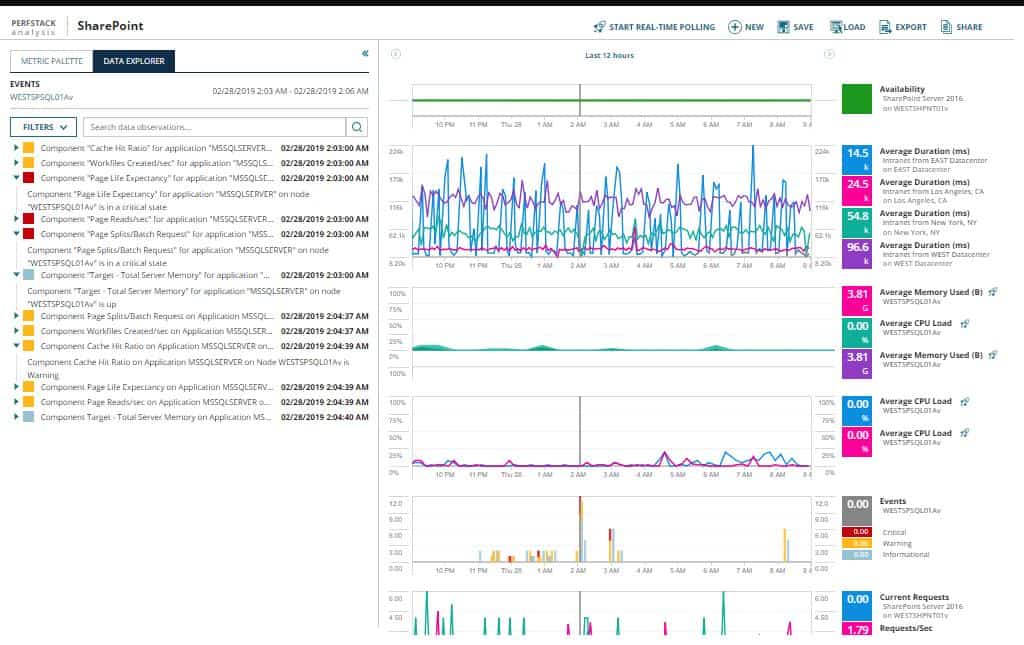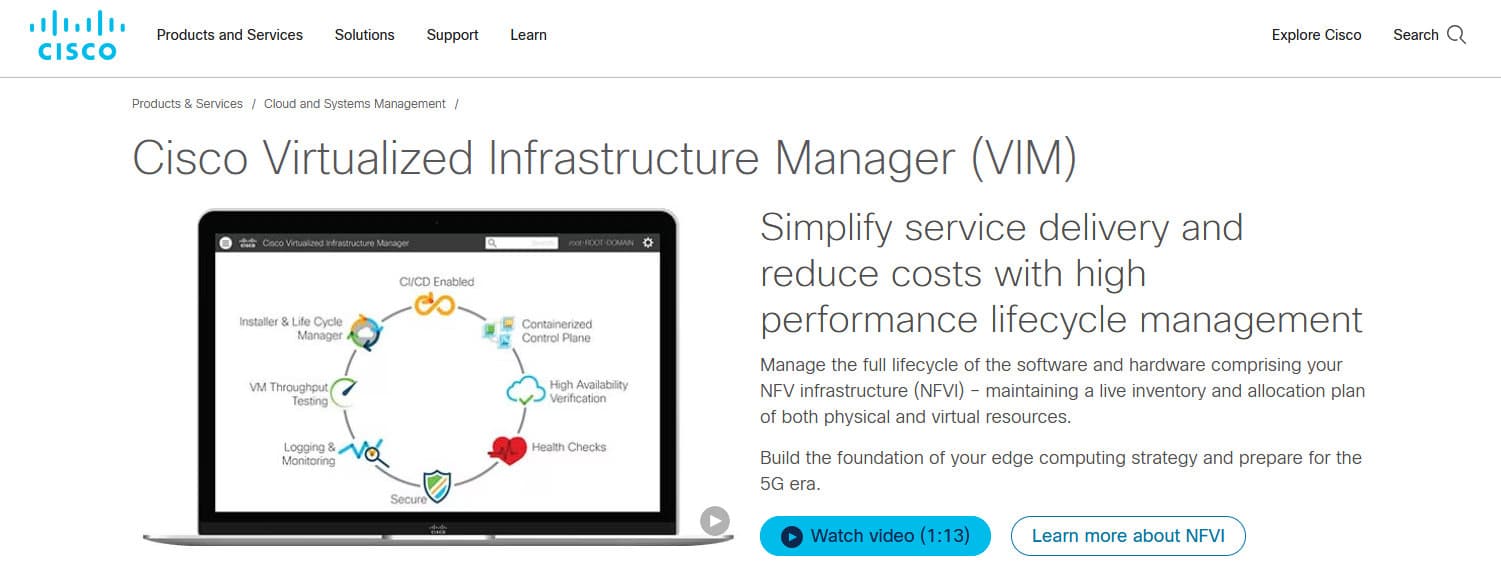We may earn a commission if you make a purchase through the links on our website.
Network Function Virtualization (NFV) Guide

UPDATED: July 16, 2024
Network Function Virtualization (NFV) has emerged as a transformative technology in the realm of network administration, offering new possibilities for flexibility, scalability, and cost efficiency. By decoupling network functions from dedicated hardware appliances and virtualizing them on standard servers, NFV enables organizations to streamline their networks, enhance service delivery, and adapt to evolving demands.
In this comprehensive guide to Network Function Virtualization (NFV), we will explore the key aspects, challenges, and benefits of this groundbreaking technology. The article will delve into specific areas of NFV that are of particular interest to network administrators, including Monitoring & Alerting, Troubleshooting Tools, and Security Features. We will also provide insights into three prominent virtualization management solutions: SolarWinds Virtualization Manager (VMAN), Cisco Virtualized Infrastructure Manager (CVIM), and VMware vCloud NFV.
The book will begin by looking at the basic notion of NFV and its architecture, demonstrating how virtualized network services may be organized and managed within a network infrastructure. We will next go into the various NFV deployment models, discussing the benefits and drawbacks of each model.
In addition, we will look at the advantages of NFV, focusing on its impact on network resilience, high availability, and resource efficiency. We will investigate the problems and limitations of NFV, focusing on issues like performance, scalability, security, and interoperability.
This guide aims to provide network administrators and operators with the knowledge and insights needed to traverse the developing environment of virtualized network infrastructure by offering a detailed introduction to NFV and its related components. This guide will be a great resource for unlocking the potential of Network Function Virtualization in your network environment, whether you are exploring the installation of NFV or seeking to improve your existing virtualization methods.
Benefits of Network Function Virtualization
NFV is a game-changing technology that provides numerous advantages to network managers and operators. NFV provides unparalleled flexibility, scalability, and efficiency to network infrastructure by detaching network services from specialized hardware appliances and virtualizing them. Here are some of the primary advantages of using NFV:
Cost Savings
By virtualizing network services on regular servers, NFV reduces the need for expensive, specialized hardware appliances. This reduces capital expense (CapEx) and operational expenditure (OpEx) connected with hardware purchase, maintenance, and power usage dramatically. Through dynamic scaling and provisioning of virtual network functions (VNFs) based on actual demand, network operators can maximize resource utilization and gain cost savings by embracing virtualization.
By operating numerous VNFs on the same physical servers, operators can maximize the use of their existing hardware infrastructure, eliminating the need for further hardware investments. Furthermore, NFV's scalability enables operators to scale network services up or down in response to variable demand, assuring effective resource allocation and reducing unnecessary expenses. This flexibility in resource management allows for more cost-effective service delivery and increases operational efficiency.
Agility and Flexibility
Network operators can flexibly scale up or down network functions as needed using VNFs running on a virtualized environment, as there are no physical hardware limits. This adaptability enables faster service delivery, faster market reaction, and the ability to adjust to changing company requirements.
Virtualized network functions can be launched, transferred, or terminated dynamically, allowing operators to respond swiftly to changes in network traffic or service needs. During peak periods, for example, additional instances of a certain VNF can be provided to meet higher traffic, and when demand drops, these instances can be automatically scaled down or terminated to free up resources. This agility in scaling and provisioning not only improves operational efficiency but also allows operators to deliver new services and applications to customers more quickly, giving them a competitive advantage in the market.
Scalability and Elasticity
NFV enables on-demand scaling of network functions, allowing for more efficient resource allocation. Based on network traffic patterns or service demands, VNFs can be dynamically constructed, moved, or terminated. This elastic scaling enables optimal resource use while removing the need for over-provisioning, resulting in better performance and cost-effectiveness.
Operators may quickly scale network functions horizontally and vertically with NFV. Horizontal scaling is creating more instances of the same VNF to manage increased traffic or workload, and vertical scaling entails providing more resources to existing instances to fulfill performance needs. The network's capacity to scale dynamically and automatically ensures that it can adapt to changing needs, resulting in a seamless user experience and optimal resource efficiency. Operators can avoid the costly practice of over-provisioning, which involves deploying additional hardware capacity to handle peak loads, and instead scale resources as needed, resulting in greater efficiency and cost savings.
Improved Network Resilience and High Availability
Network operators can increase network resilience with NFV by utilizing virtualized network functions (VNFs). VNFs can be seamlessly relocated to available resources in the case of failures or congestion, preventing service disruptions. This dynamic resource allocation ensures that network functions can react to changing conditions while maintaining service continuity. For example, if a physical server that hosts a VNF suffers a hardware breakdown, the VNF can be instantly transferred to a healthy server without disrupting existing activities. This functionality improves network fault tolerance and decreases the impact of hardware failures.
Furthermore, NFV provides load balancing between virtualized resources, which improves network resilience and performance. NFV may balance workloads and avoid bottlenecks by distributing network functions across numerous servers. When traffic or resource needs increase, more instances of VNFs can be launched and load balanced to manage the additional load. This dynamic load balancing capability ensures effective resource utilization, lowers congestion risk, and improves overall network performance.
NFV Architecture
The architecture of NFV provides a framework for virtualizing and controlling network services in a flexible and scalable manner. It is made up of many components that work together to enable network function virtualization and orchestration. Understanding the NFV architecture is critical for effectively implementing and deploying NFV solutions.
The NFV architecture comprises three main components:
- Virtualized Network Function (VNF) A virtualized network function (VNF) is the virtualized equivalent of a physical network function (PNF) or a network appliance. It wraps network function software and runs on NFV infrastructure virtual machines or containers. Each VNF handles a different network function, such as routing, switching, firewalling, or load balancing. VNFs can be deployed, instantiated, and scaled as needed, providing network operators with agility and flexibility.
- NFV Infrastructure (NFVI) The NFVI is the underlying infrastructure that allows VNFs to run. Its components include physical computational resources (servers), storage, and networking. The NFVI offers all the resources required to host and run VNFs, such as compute resources, memory, storage, and network connectivity. Hypervisors and containers, for example, are used to generate virtual instances in which VNFs can be deployed. The NFVI also comprises management and orchestration (MANO) components, which are in charge of resource allocation, scaling, and VNF lifecycle management.
- Management and Orchestration (MANO) MANO is an important component of the NFV architecture, as it is in charge of managing and orchestrating the VNFs and NFVI resources. It is made up of three functional blocks:
- Virtualized Infrastructure Manager (VIM) The VIM is in charge of managing NFVI resources such as computing, storage, and network. It is in charge of activities including resource allocation, scaling, and monitoring. VIM works with the NFVI to guarantee that the resources needed for VNF deployment and operation are available.
- VNF Manager (VNFM) The VNFM is in charge of managing the lifetime of VNFs, which includes instantiation, scaling, monitoring, and termination. It communicates with VNFs and manages their activities within the NFV infrastructure. VNFM communicates with VIM to request and manage the resources needed by VNFs.
- Orchestrator The Orchestrator is in charge of orchestrating and coordinating many VNFs and their interconnections to deliver network services from start to finish. It collaborates with the VNFM and VIM to allocate resources, connect VNFs, and handle service chaining. The Orchestrator ensures that VNFs are deployed and operated by service requirements and policies.
The NFV architecture provides a standardized framework for virtualizing, controlling, and scaling network functions. By detaching network operations from proprietary hardware appliances and permitting their implementation on commodity hardware, it provides flexibility, scalability, and cost savings. NFV enables operators to maximize resource use, rapidly launch new services, and dynamically scale network functions to meet changing demands by leveraging virtualization technology and orchestration capabilities.
NFV Deployment Models
NFV offers many deployment options that give flexibility and adapt to a wide range of network requirements. These deployment models specify how NFV components are installed and structured in a network architecture. Understanding NFV deployment models is critical for network managers and operators to select the best approach for their requirements.
Single-Site Deployment
In this paradigm, NFV components such as virtualized network functions (VNFs), management and orchestration (MANO), and the NFV infrastructure (NFVI) are implemented in a single site or data center. This architecture is appropriate for smaller networks or enterprises that have centralized infrastructure. Because all components are located in the same physical place, it streamlines resource management and coordination. However, if the single site fails or is disrupted, it may lack geographical redundancy and high availability.
Multi-Site Deployment
In this model, NFV components are deployed across multiple locations or data centers. Each site houses a subset of the NFV infrastructure, such as computational resources, storage, and networking components. Based on parameters such as geographical proximity or network traffic patterns, VNFs can be spread between various sites. Geographic redundancy, load balancing, and enhanced fault tolerance are all advantages of multi-site deployment. If one site has a problem, traffic can be diverted to another, providing service continuity. However, controlling and organizing resources across numerous sites can be more difficult, necessitating strong inter-site connections.
Edge Deployment
Bringing NFV capabilities closer to the network edge, or closer to end-users or devices, enables low-latency and localized services. VNFs and accompanying NFVI components are deployed in edge locations such as customer premises, remote sites, or mobile base stations under this paradigm. Edge deployment allows for effective service delivery for latency-sensitive applications, as well as reduced backhaul traffic and localized processing capabilities. It is especially useful for applications such as edge computing, IoT, and real-time analytics. However, resource limits, limited power and cooling capabilities, and managing a distributed infrastructure may pose hurdles to edge deployment.
Hybrid Deployment
A hybrid deployment combines different NFV deployment strategies to maximize the benefits of each. Based on the individual network requirements, it combines single-site, multi-site, and edge installations. An organization, for example, may have a centralized data center for core network functions (single site), many regional sites for load balancing and redundancy (multi-site), and edge locations for low-latency services. A hybrid deployment is a flexible and scalable technique that enables organizations to optimize resource allocation and service delivery based on their specific requirements.
SolarWinds Virtualization Manager (VMAN)

SolarWinds Virtualization Manager (VMAN) is a complete virtualization management solution that is meant to simplify and optimize virtualized infrastructure management. Network administrators may obtain deep insight, performance monitoring, and capacity planning capabilities for virtualized environments using VMAN, allowing them to manage and optimize their virtualization installations more efficiently.
Key Features:
- Virtualization Performance Monitoring (VMAN): VMAN monitors and analyzes the performance of virtual infrastructure in real-time, including virtual machines (VMs), hosts, clusters, and data stores. It provides precise information about resource utilization, CPU, memory, storage, and network performance indicators, assisting administrators in identifying performance bottlenecks, troubleshooting issues, and ensuring optimal VM performance.
- Virtual Machine Sprawl Control: VMAN addresses the issue of VM sprawl by giving visibility into VM provisioning, utilization, and resource allocation. It allows administrators to identify empty or underutilized virtual machines, reclaim lost resources, and enforce virtual machine deployment standards. This optimizes resource consumption, increases efficiency, and lowers infrastructure costs.
- Capacity Planning and Optimization: VMAN includes capacity planning and optimization tools that enable administrators to estimate resource requirements, plan for future expansion, and optimize resource allocation. It provides insights into historical trends, consumption patterns, and performance statistics to help with right-sizing VMs, recognizing resource contention, and making educated infrastructure expansion decisions.
- Integration with the SolarWinds Orion Platform: VMAN interacts smoothly with the SolarWinds Orion Platform, a single monitoring and management platform. Administrators may now correlate virtualization data with network, storage, and application performance indicators, offering a comprehensive view of the overall IT environment. It allows for cross-domain troubleshooting, root cause analysis, and end-to-end visibility for total infrastructure management.
- Alerts and Reporting: For proactive monitoring and issue detection, VMAN provides configurable alerts and notifications. Administrators can set thresholds and receive notifications when there is anomalous activity, performance degradation, or capacity limits. VMAN also offers pre-built and configurable reports for capacity planning, performance analysis, and compliance auditing, allowing administrators to develop useful insights and share information with stakeholders.
Cisco Virtualized Infrastructure Manager (CVIM)

Cisco Virtualized Infrastructure Manager (CVIM) is a comprehensive management solution designed to facilitate virtualized infrastructure deployment and maintenance inside Cisco's ecosystem. CVIM offers complete management capabilities for Cisco's virtualized infrastructure, including computing, storage, and networking components, enabling network administrators to manage and coordinate their virtualized environments more efficiently.
Key Features of Cisco:
- Centralized Management: CVIM provides a single management platform for managing and orchestrating virtualized infrastructure. It gives administrators a single pane of glass view to monitor, configure, and manage virtual resources across many data centers or sites. By offering a unified interface for managing virtual machines (VMs), hosts, storage, and network resources, this centralized solution simplifies operations and increases efficiency.
- End-to-End Visibility: CVIM gives administrators extensive access to the virtualized infrastructure, allowing them to monitor and troubleshoot the performance and health of VMs, hosts, and networking components. It provides real-time monitoring of resource use, performance data, and alerts to help identify and resolve issues as they arise. CVIM's end-to-end visibility ensures optimal performance, effective resource usage, and better overall infrastructure management.
- Intelligent Resource Allocation: CVIM makes intelligent resource allocation and optimization possible. Administrators can use it to assign computing, storage, and network resources based on business priorities, workload requirements, and service level agreements (SLAs). CVIM uses policy-based automation and sophisticated analytics to assign and balance resources in real time, assuring effective use and eliminating waste.
- Service Assurance and SLA Management: CVIM contributes to service assurance by allowing administrators to design and enforce service-level agreements (SLAs). It offers SLA compliance monitoring and reporting, as well as insights into performance, availability, and other essential parameters. By delivering alarms, performance dashboards, and configurable reports, CVIM assists administrators in proactively addressing issues and maintaining service levels.
- Integration with Cisco Ecosystem: CVIM works smoothly with other Cisco technologies like Cisco UCS (Unified Computing System) and Cisco ACI (Application Centric Infrastructure). This interface allows managers to take advantage of all of Cisco's virtualized infrastructure capabilities, such as policy-driven automation, streamlined network provisioning, and unified administration. The integration with Cisco's ecosystem delivers a comprehensive and unified experience for controlling and coordinating virtualized systems.
NFV Challenges and Limitations
While Network Function Virtualization (NFV) has many advantages, it also has several drawbacks and restrictions that network managers and operators should be aware of. Understanding these issues is critical for properly developing and deploying NFV solutions. Ultimately, NFV adds another layer of software abstraction and virtualization, which can have an influence on performance and increase delay.
The performance of virtualized network operations running on general-purpose hardware may not always match that of specialized hardware appliances. To avoid performance degradation or latency difficulties, network administrators must carefully examine performance requirements and design their virtualized environments. As the number of virtual network functions (VNFs) grows, it becomes more difficult to manage scalability and resource allocation. Resource contention, insufficient capacity planning, and inefficient resource utilization can all influence network performance and availability. To enable optimal scalability and resource usage, effective resource management and orchestration are required.
NFV brings new security problems, especially linked to shared infrastructure and potential virtualization layer vulnerabilities. It is critical to ensure sufficient isolation and security between VNFs to avoid unauthorized access and potential attacks. To ensure the integrity and confidentiality of network services and data, it is critical to implement strong security measures such as virtual firewalls, access controls, and encryption.
Because NFV incorporates various manufacturers and technologies, interoperability issues may arise. Interoperability and flexibility might be hampered by a lack of defined interfaces and protocols among different NFV components, as well as vendor-specific implementations. To minimize vendor lock-in and accomplish smooth integration of NFV solutions, network managers must assure compatibility and interoperability between different NFV components.
Integrating NFV with legacy systems and infrastructure might be difficult. Legacy systems may lack native virtualization capabilities or interoperability with NFV components. Migrating existing network services and operations to a virtualized environment necessitates careful planning and may necessitate significant effort and expenditure.
Another major consideration is cost. While NFV is ultimately designed to save money by consolidating hardware and increasing resource utilization, there may be certain upfront expenses involved with establishing and operating NFV infrastructure. To ensure that the benefits of NFV surpass the related expenses, organizations must carefully examine the total cost of ownership, which includes hardware, software, licensing, training, and maintenance.